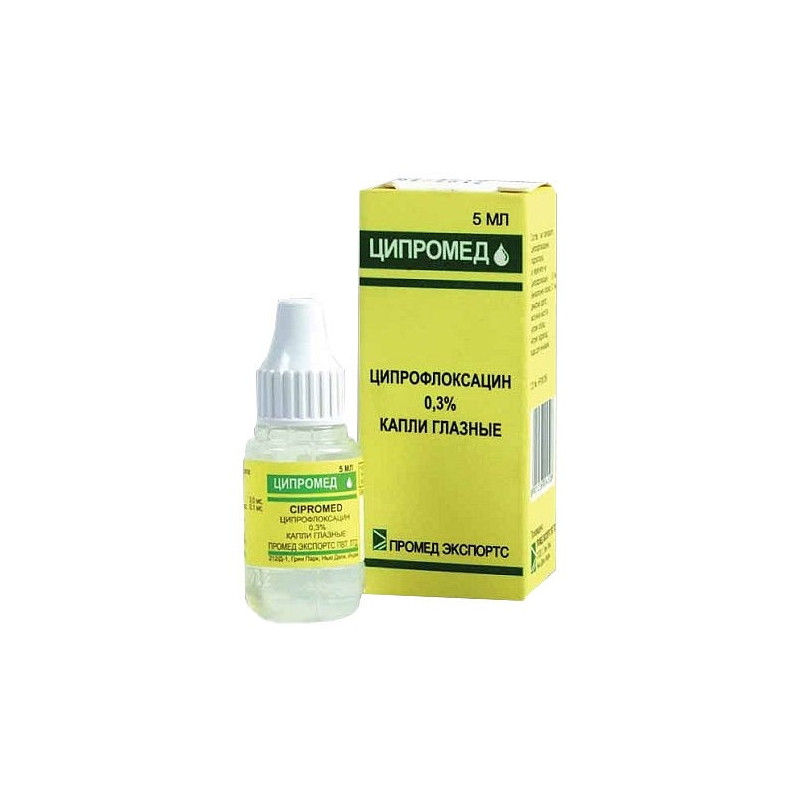



 All payments are encrypted via SSL
All payments are encrypted via SSL
 Full Refund if you haven't received your order
Full Refund if you haven't received your order
eye drops - clear solution from colorless to pale yellow.
Each ml of the preparation contains Ciprofloxacin hydrochloride - 3 mg, Benzalkonium chloride - 0.1 mg, Sodium salt, Lactic acid, Sodium chloride, Sodium hydroxide, Water for injection q / s;
0.3% solution of 5 ml in a plastic dropper bottle in a carton box.
pharmachologic effect
Cypromed - antibacterial drug from the group of fluoroquinolones, has a wide spectrum of antibacterial action, has a bactericidal effect. The drug inhibits the enzyme DNA gyrase of bacteria, as a result of which DNA replication and the synthesis of bacterial cellular proteins are impaired. Ciprofloxacin acts both on reproducing microorganisms and on those at rest.
The spectrum of antibacterial action of ciprofpoxacin includes gram-negative microorganisms: Esherichia coli, Salmonella spp., Shigella spp., Proteus spp. (indolpositive and indole negative), Morganella morganii, Citrobacter spp., Klebsiella sf., Enterobacter spp., Vibrio spp., Campylobacter sf., Legionella pneumophila, Neisseria spp., Moraxelja catarrhaMs, Acinetobacter spp., Brucella spp., Chlamidia spp.
Gram-positive microorganisms are also sensitive to ciprofloxacin:
Staphylococcus spp., Streptococcus pyogenes, St. Agalactiae, Coryne bacterium, diphtheriae, Listen a monocitogenes. The drug has low toxicity.
When applied topically, ciprofloxacin penetrates well into eye tissue.
Indications
Bacterial inflammatory diseases of the eye and its appendages:
- acute and subacute conjunctivitis,
- keratitis;
- anterior uveitis;
- blepharitis and other inflammatory diseases of the eyelids;
- dacryocystitis;
- prevention and treatment of infectious complications after injuries of the eye and its appendages and during operations on the eyeball.
Hypersensitivity to the components of the drug or to other quinolones, pregnancy, breastfeeding, and children up to 1 year.
Cypromed instill 1-2 drops in the conjunctival sac. The frequency of instillation depends on the severity of the inflammatory process.
For acute bacterial conjunctivitis, simple, scaly and ulcerative blepharitis, Cypromed is prescribed 4 to 8 times a day, depending on the severity of the disease. The course of treatment is from 5 to 14 days.
With keratitis, the drug is administered 1 drop at least 6 times a day; if there is a positive effect, the maximum course of treatment, depending on the severity of corneal damage, is 2-4 weeks.
With the defeat of the cornea Pseudomuscular bacillus
Cypromed is prescribed as often as possible - at least 8-12 times a day, 1 drop. The course of treatment depends on the secretion of the disease and is usually about 2-3 weeks.
With anterior uveitis, the drug is instilled 8-12 times a day, 1 drop.
For acute dacryocystitis and canaliculitis, Cypromed is prescribed 6–12 times a day, for chronic 4–8 times a day, 1 drop.
In case of injuries of the eye and its appendages for the prevention of secondary infection, Cypromed is prescribed for 1-2 weeks 1 drop 4-8 times a day.
For the prevention of inflammatory diseases after surgical interventions with perforation of the eyeball, Cypromed is prescribed 4-6 times a day, 1 drop for the entire postoperative period, usually from 5 days to 1 month.
Immediately after instillation, there may be a slight burning sensation within 1-2 minutes, itching, soreness, hyperemia of the mucous membrane of the eye. Allergic reactions may develop. Eyelid edema, photophobia, lacrimation, foreign body sensation in the eyes, unpleasant taste in the mouth immediately after instillation, reduced visual acuity, the appearance of a white crystalline precipitate in patients with a corneal ulcer, keratitis, staining or infiltration of the cornea, the development of superinfection.
In case of accidental intake of Tsipromed inside, there are no specific symptoms.
Nausea, vomiting, diarrhea, headache, fainting, feelings of anxiety are possible.
Treatment: the usual emergency measures, sufficient intake of fluid in the body, creating an acidic urine reaction to prevent crystalluria.
Ciprofloxacin solution is incompatible with drugs with a pH value of 3-4, which are physically or chemically unstable.
If the patient wears soft contact lenses, then he should not use Tsipromed, as the preservative may be deposited in soft contact lenses and have an adverse effect on eye tissue. You should remove hard contact lenses before instillation of the drug and put them on again only after 15 minutes.
When using other ophthalmic drugs, the interval between their administration should be at least 5 minutes.
Immediately after instillation of the drug, it is possible to reduce the clarity of vision and slow down mental reactions, which can reduce the ability to actively participate in traffic, machine maintenance or to perform work without support. This is even more so with the simultaneous use of the drug with alcohol.
List B. At room temperature (up to 25 ° C) protected from light and inaccessible to children. Do not freeze.
Shelf life - 2 years.
Shelf life after opening the bottle 1 month.
